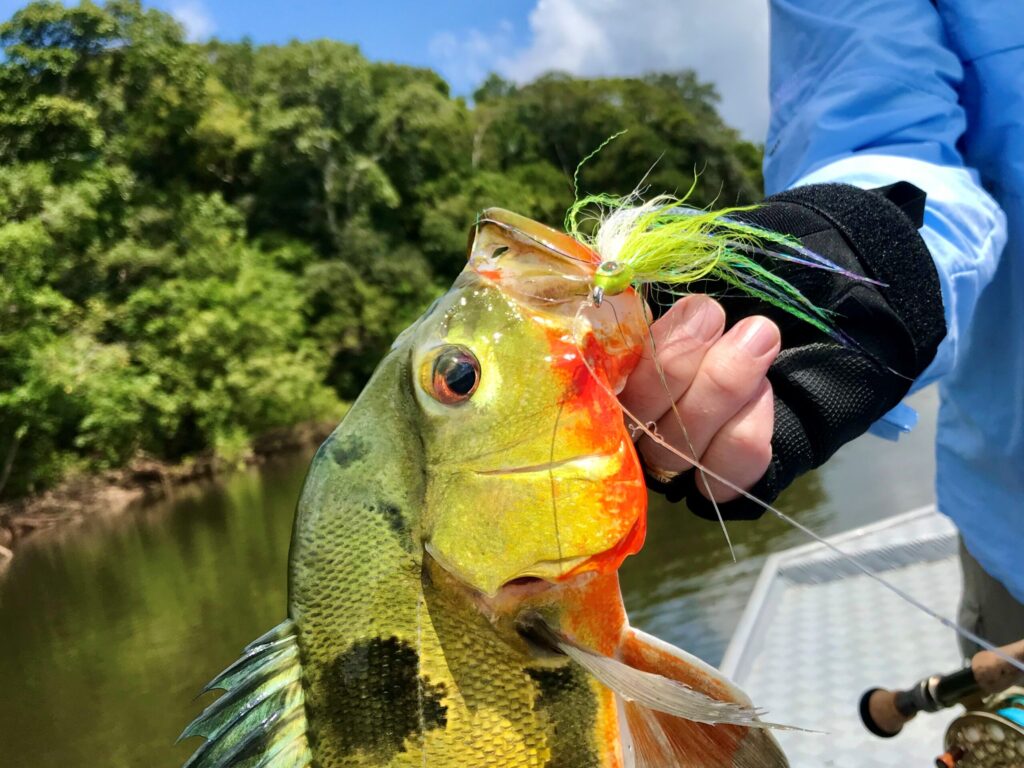
Giant Peacocks on the Fly in the Amazon Basin
“Beside rivers, we seldom fill our minds with fears of many things that will never be. Here honest, civil, quiet men are free from dread…. Rivers and the inhabitants of the watery element were made for wise men to contemplate and fools to pass by.”
Isaac Walton
By Brian R. Smith
I lifted the tip of my 9 weight fly rod and flipped it forward to do a roll cast and straighten out the line; with rod tip pointed at the water, standing in the bow of the boat, I lifted it up again and at the hard stop the line laid out behind me, loaded the rod, and then came forward watching the tight loop stretch out before me, straighten, and then the red and yellow streamer landed on the water right on the edge of a mass of roots and limbs in the back of a pocket of water in flooded timber off of the Xeruini River in Brail’s Amazon Jungle. With the fly falling in an acceptable position I strip sharply once to get the attention of the fish, continuing with a quick, jerky retrieve. A foot from the edge of the structure a fish aggressively takes the fly and turns to the side. I continue the strip with my left hand until I come up tight. Then with the butt of the rod in my hip and the rod tip low, I hit two or tree times hard.
The fish is in the air, upside down, then makes a run taking the loose line coiled at my feet with it. I clamp down on the line with my left hand on the cork to stop it from taking more line and getting under the structure to break me off. I am thinking about my knots, hoping I tied them well, I am confident in the 40-pound mono that I had used for the leader if I can just keep him out of the deadfall in the water. Mo, my guide, is backing the boat up with the trolling motor trying to back up into open water and with the line clamped down to the cork with my left had I am reeling up the excess coils with my right hand. Once I have most of the line on the spool, I let go of the line with my left hand all the rest of the slack is gone in an instant and now we are on the reel. Now the fish is burning off line from my reel, the drag on my Reddington reel not having much effect, and I am palming my reel trying to slow this freight train. Finally, after peeling another 40 yards of line off my reel I am able to slow him down. I have a deep bend in my rod, and he is working sideways as I reel down and pull trying to work him back to the boat. This fish feels heavy and strong as I continue to work him up to within ten yards of the boat and he comes to the surface and it boils. I can see the bright yellow sides with the black vertical bars, and the red gills of a giant Peacock Bass, this variety the three barred Acu, through the clear, leaf stained water of the Xeruini. Mo maneuvers to the side of the boat with the net, I can tell he is as excited as I am because this is a big fish. I lift my rod tip, steering his head toward the net, he sees the boat and does an abrupt about face and starts peeling off all the line I had just gained back off my reel. I instinctively reach up to grab the handle of the reel and the line is burning off so fast I beat up my knuckles on the reel handle and slide my hand under the reel and begin palming it again trying to slow down the retreat. This sequence of events is repeated five times before the big guy begins to tire and I am able to steer his head into the net with my rod bent to the cork and then he is in the boat and we are doing “high-fives”.

This brute weighed in at 15 pounds and measured 36 inches in length. We quickly take our photos of this beautiful and powerful fish and then we quickly get him back into the water, holding him beside the boat where he is quickly revived then shoots back towards the structure to live another day.
This fish is not technically a bass as it belongs to the genius Chichla of which there are fifteen different species. This variety is the Cichia Temensis, the largest of the species. The true giant Peacock Bass is not found outside of the Amazon basin. You can’t find then in Florida or Hawaii or Panama because they are simply not there. Other species of varieties are there, however not the Cichla Temensis. Their natural range consists primarily of backwater flood pulse rivers with extremely variable seasonal environments in South America’s Amazon regions. They are native to the Rio Negro basin which is where this took place. The Xeruini is a tributary of the Rio Negro in the Rio Negro Basin. These are very aggressive fish and produce the most exciting predatory attacks of any sportfish in the world. Frankly, no other freshwater fish compares, anywhere. This fish has earned the reputation of the world’s most powerful and challenging freshwater game fish.

Amazon Peacocks live in the most pristine and exotic habitats on earth. Jungle lined black-water rivers, hidden lagoons and white-sand scalloped beaches are just some of the spectacular settings in their native environment. The alien-appearing, isolated still waters lend a counterpoint to their sudden, violent and explosive attacks. And there are lots of other fish, ranging from acrobatic aruana to hulking giant catfish. Even if there were no fish at all, the Amazon environment alone creates a hauntingly beautiful experience.
Brian Smith
Brian R. Smith is an avid outdoorsman passionate about fly fishing, wing shooting, Safari hunting, and equestrian activities. He lives with his wife Gretchen in Alabama, and together they enjoy spending time with their horses and sporting dogs on trails, rivers, and in the sporting field. To read more of Brians adventures, you can follow him on Instagram @bohemianadventure


You May Also Like

Holiday Gift Ideas: 2022
November 8, 2022
Five Quotes About Whiskey
January 17, 2020